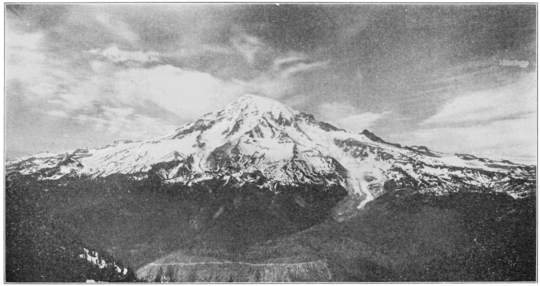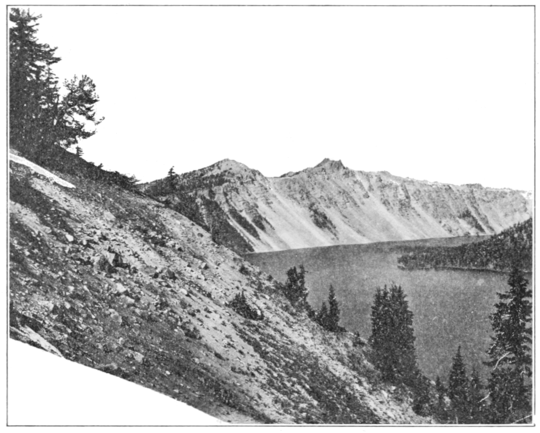Popular Science Monthly/Volume 80/June 1912/The National Parks from the Scientific and Educational Side
| THE NATIONAL PARKS FROM THE SCIENTIFIC AND EDUCATIONAL SIDE |
By LAURENCE F. SCHMECKEBIER
WASHINGTON, D. C.
THE passage of the act of Congress creating the first national park—the Yellowstone—was due in large measure to the interest and activity of the chief geologist of the Geological and Geographical Survey of the Territories, Dr. F. V. Hayden, and in the forty years that have elapsed since the creation of that great reservation the wonders of the national parks have claimed the attention of workers in every branch of science. As might naturally be expected, the more extensive scientific work in the parks has been in the field of geology and its allied sciences, because the wonderful forms of nature which have been the main factors in inducing congress to create these parks are the result of forces whose study falls particularly within the realm of geology. In the Yellowstone Park the geysers, the hot springs, the terraces, the fossil forests and the Grand Canyon of the Yellowstone River present absorbing and instructive geologic problems; in the Mount Rainier National Park is one of the largest glacial systems known to radiate from a single peak; in the Crater Lake National Park is the only lake in the United States that is situated in the caldera of an extinct volcano; in the Yosemite National Park the great gorge of Yosemite Valley presents perplexing problems to the student of physiography and widely divergent theories have been advanced regarding its origin; in the Glacier National Park are over 80 glaciers varying from a few yards to five acres in extent that have received practically no attention from the student of glaciology. But geology can not lay claim to the entire field. At the Hot Springs Reservation of Arkansas the healing waters are of great interest to the chemist and physician as well as to the geologist, and in the Mesa Verde National Park the remains of the vanished race of cliff dwellers offer a prolific field to the ethnologist and anthropologist. In the Yellowstone, Mount Rainier, Crater, Yosemite, Sequoia and General Grant Parks there is a prolific flora of native trees, flowers and grasses such as can be seen in few places in the west. In all the parks the protection of the game affords opportunity for the study of many faunal species that have been almost exterminated except in these reservations.
The scientific bureaus of the government and various learned societies have issued publications on the parks that are accessible to the Head of Lake St. Mary, Glacier National Park.
scientific traveler who knows where to look for data and who has access to the libraries in which these publications are deposited. But to
Iceberg Lake, Glacier National Park.
the tourist or the teacher who does not have access to large collections neither the government nor the scientific societies have offered any assistance in his search for information. The publications either are not generally available or are so voluminous and technical that the general reader is repelled rather than encouraged to seek information.
During the season of 1911 over 90,000 persons visited the national parks, not including the visitors to the Hot Springs of Arkansas. The majority of these tourists are intelligent and educated people anxious to learn something about the causes underlying the wonders they are witnessing. Every one who has seen the beautiful and brilliant pools
Paradise Park and Mount Rainier.
in the Yellowstone Park is at least curious to know the cause of the harmonious and delicate coloring. The guides and stage drivers generally state that the colors are due to mineral matter, and as most people usually associate color with mineral the tourist goes home fully convinced, when as a matter of fact the color in the pools is due to the growth of algæ, as has been conclusively shown by Mr. Hague and Mr. Weed.
The officers of the Department of the Interior, which has charge of the national parks, have reached the conclusion that a series of short scientific publications on the parks will not only add to the pleasure of Mount Ranier, Gap Point and Paradise Valley.
the tourist but serve an extremely useful educational purpose by disseminating the results of scientific work. It is therefore planned to issue a number of short publications describing the phenomena in the various parks and explaining the causes and forces that have produced them. It is not contemplated that the department will embark on original investigations, as it is believed that more material can be obtained than can be printed with the funds available, but it is hoped to revise some of the papers already published and issue them in pamphlet form. The department has just issued the following publications: "Geologic
Mount Rainier, from Kautz Fork. Mount Rainier National Park.
History of the Yellowstone Park," by Arnold Hague; an account of the geysers of the Yellowstone Park, including a comparison with the geysers in New Zealand and Iceland, by Walter Harvey Weed, and the geologic history of Crater Lake, by Joseph S. Diller. These publications are illustrated with well-selected half-tones and carefully prepared black and white maps based on the accurate topographic maps issued by the Geological Survey.
The first need of the intelligent traveler is a map of the area he is about to traverse. Fortunately excellent maps of almost all the larger parks are for sale by the United States Geological Survey at nominal prices. Maps have been published of Yellowstone, Yosemite and Glacier national parks on a scale of 2 miles to the inch; of the Crater Hot Spring Yellowstone National Park
These terraces are composed of nearly pure travertine that has been deposited by the waters from the hot springs.
Lake Park on a scale of one mile to the inch and of Yosemite Valley on a scale of 2,000 feet to the inch. Separate maps of the Sequoia and General Grant parks have not been published, but the topography of these parks is shown on the regular atlas sheets issued by the Geological Survey. A part of the field work has been completed on the maps of the Mount Rainier and Mesa Verde national parks and the surveys will be finished during the coming summer. These maps should be ready for the season of 1913. All of these maps are in three colors, the drainage being shown in blue, the relief in brown and the culture or works of man in black. In addition the Department of the Interior has prepared tourist-travel maps of the Yosemite, Yellowstone, Glacier, Crater Lake, Sequoia and General Grant national parks. These maps will be in black only and will be used as doable-page illustrations in
some of the pamphlets in preparation. While they have been carefully prepared they are not intended to be substitutes for the more expensive and elaborate maps printed in colors.
Yosemite Valley from Mohan's Point.

Yosemite Falls. The upper fall is 1,430 feet; then come cascades, partly hidden, in which the fall is 675 feet, and finally a drop of 820 feet.

This lake is situated in the crater of an extinct volcano. The upper portion of the mountain has collapsed leaving the caldera.
Southern Shore of Crater Lake.
From Castle Crest, Crater. The phantom ship is seen on the left.
Western Border of Crater Lake.
National Park in Oregon and the Rio Grande National Park in New Mexico. A bill was introduced in the last congress providing for the creation of the Grand Canyon National Park. The Grand Canyon now has the status of a national monument in a forest reserve. The creation of the following national parks has been advocated, but no bills have been introduced providing for them: The Kilauea National Park around the volcano of Kilauea in Hawaii and the Estes National Park in Colorado.
The secretary of the interior is also charged with the supervision of seventeen national monuments created by executive proclamation under authority of the act of congress approved June 8, 1906. This act authorizes
the President "in his discretion, to declare by public proclamation historic landmarks, historic and prehistoric structures, and other objects of historic or scientific interest that are situated upon the lands owned or controlled by the government of the United States to be national monuments." The national monuments under the supervision of the secretary of the interior are as follows: the Devils Tower, a landmark in Wyoming; Montezuma Castle, Tumacacori, Chaco Canyon and Gran Quivira in New Mexico, and Navajo in Arizona—prehistoric or Spanish ruins; Muir Woods in California—a beautiful redwood grove presented to the government by William Kent; El Morro in New Mexico—a rock containing inscriptions made by the early Spanish explorers; Pinnacles in California—a group of spire-like formations underlain by caves; Mukuntuweap in Utah—a peculiar and beautiful gorge; Shoshone Cavern in Wyoming and Lewis and Clark Cavern in Montana—limestone caves of great beauty; Natural Bridges and Rainbow Bridge in Utah—the four largest natural bridges in the world; Sitka in Alaska—the location of one of the earliest settlements and containing some of the finest totem poles known; Colorado in Colorado—an area of eroded monoliths similar to the well-known Garden of the Gods near Colorado Springs; Petrified Forest in Arizona—an area containing large deposits of silicified wood. Ten other national monuments are administered by the Department of Agriculture. That the parks have been administered so ably and successfully is due to the faithful and devoted work of the officers in charge for many years. By much work beyond the regular office hours these officials have managed to attend to the pressing questions and the current business
that have come before them. But there has been neither time nor energy for planning a series of publications such as have been outlined and it has been extremely difficult to make the limited beginning described above. The essential things have been done, but many desirable things have perforce been left undone.
Spruce Tree House, Cliff Dwellings, Mesa Verde National Park, Colo.
Cliff Palace, Mesa Verde.
The number of visitors to the national parks has increased from 30,000 in 1906 to 93,000 in 1911. With this increase in the number of visitors the administrative problems have increased, and in order that national park affairs may receive the careful and detailed consideration they deserve, Secretaries Ballinger and Fisher have advocated the creation of a bureau of national parks. President Taft has warmly approved the proposal to create this bureau and in his message of February 2, 1912, referred to it as follows:
One of the chief functions of such a bureau should be to arrange a series of publications that will deal clearly and in general terms with the geology, the botany and the zoology of these great reservations that are being administered by the government for the benefit of the people. The educational value of such a series of publications can hardly be estimated.



















